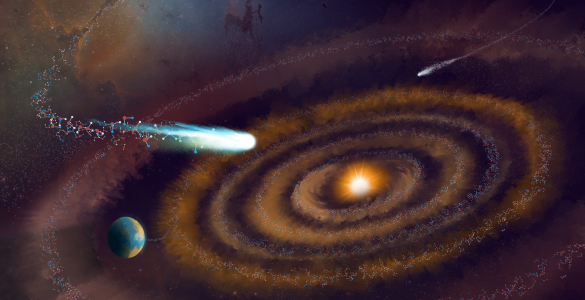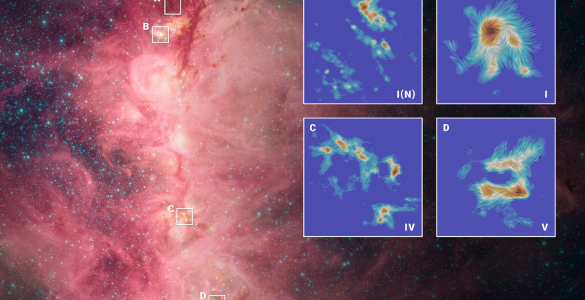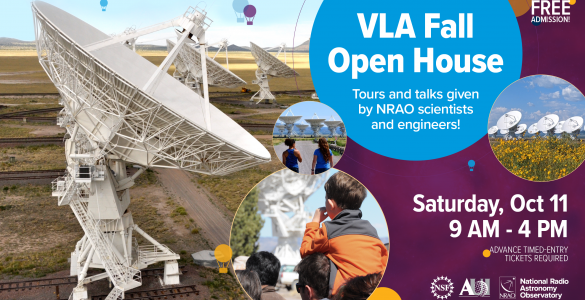The United States and Canada intend to collaborate on two of the most important radio astronomy projects of the new century — the Atacama Large Millimeter Array (ALMA) and the Expanded Very Large Array (EVLA), astronomers from both countries announced today.
“This cooperative program — the North American Partnership in Radio Astronomy — involves the key projects that will dominate radio astronomy world-wide,” said Paul Vanden Bout, director of the National Radio Astronomy Observatory (NRAO). “This partnership will multiply the efforts of both nations’ astronomers for the benefit of science. It builds on a long tradition of cooperative efforts in radio astronomy, and will ensure that we continue that tradition into the new millennium,” Vanden Bout said.
The U.S.-Canada radio astronomy partnership is outlined in two letters of intent signed recently. The first, between the U.S. National Science Foundation (NSF) and Canada’s National Research Council (NRC), states that both agencies will use their best efforts to obtain the necessary funding for construction and operation of ALMA. The second, between the National Radio Astronomy Observatory, funded by the NSF, and the Herzberg Institute of Astrophysics, funded by the NRC, forms a partnership in the EVLA.
The VLA Expansion Project is a two-phase program designed to improve the scientific capabilities of the VLA tenfold by replacing 1970s-vintage equipment with modern technologies and adding new radio-telescope antennas to the existing 27-antenna array. Dedicated in 1980, the VLA has been used for more than 10,000 observing projects covering nearly every area of astrophysics. It is the most powerful, flexible and widely-used radio telescope in the world. The Expanded VLA will provide the improved observational capabilities needed to meet the research challenges of the coming years. In addition to the participation by Canada, funds have been pledged by Mexico. Both Mexico and Germany have funded VLA improvements in the past. A proposal to the NSF requesting U.S. funds for the EVLA is currently under review by the National Science Foundation.
The agreement between the NRAO and the Herzberg Institute of Astrophysics (HIA) calls for HIA to build a new correlator — the digital “heart” that combines the received signals from multiple antennas to make those antennas work as a single, powerful telescope — for the EVLA. The new correlator will represent a contribution of $10 million (US$). The full EVLA project will cost about $150 million, to be done in two phases, the first costing $75 million.
“Canada has a strong program of radio astronomy, and in particular a skilled team of specialists in designing correlators, and we are pleased to have their talents directed toward building a new machine for the VLA,” Vanden Bout said.
ALMA will consist of 64 12-meter-diameter dish antennas comprising a single imaging telescope to study the universe at millimeter and submillimeter wavelengths — the region between radio waves and infrared waves. An international project being designed and developed by the U.S. and European nations, ALMA will be located on a high-altitude site in the Atacama desert of Chile.
“ALMA will give scientists an unprecedented look at the structure of the early universe and revolutionary insights on how stars and planets form, among many other contributions,” Vanden Bout said. “The EVLA will bring unmatched power and versatility to the study of objects as close as the Sun and planets and as far as primeval galaxies at the edge of the observable universe. Together, these two instruments will be at the forefront of 21st Century astrophysics,” he added.
“ALMA has been a bilateral project involving the United States and Europe. These new agreements with Canada turn ALMA into a partnership between Europe and North America,” Vanden Bout said.
Design and development work on ALMA has been ongoing since 1998, funded by the NSF and European organizations. Canadians already have participated in this work. ALMA is planned for completion this decade. The new partnership calls for Canada to seek funding for a $20 million (US$) contribution toward construction of ALMA. The total construction cost of ALMA is $552 million (2000 US$), to be shared equally between Europe and North America.
Under both letters of intent, applications for observing time on ALMA and NRAO radio telescopes, including the VLA, the Very Long Baseline Array (VLBA), and the Green Bank Telescope (GBT), from Canadian scientists will be treated the same as applications from U.S. scientists. Also, Canadian scientists will be appointed to NRAO advisory and oversight committees, and U.S. scientists will be appointed to similar Canadian committees.
The National Radio Astronomy Observatory is a facility of the National Science Foundation, operated under cooperative agreement by Associated Universities, Inc.
Contact:
Dave Finley, Public Information Officer
(505) 835-7302
dfinley@nrao.edu















